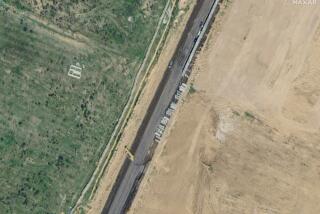Walls always tumble down
- Share via
TODAY, 1,616 MILES remain of the Great Wall of China, the longest and most ambitious defensive wall ever built. But, in fact, the wall’s usefulness was disproved in 1213, when the Mongol armies of Genghis Khan poured over and through it as they swept victoriously into China.
Equally futile was the Maginot Line, a giant concrete wall festooned with huge guns and built by the French after World War I to repel some future German invasion. But when World War II arrived, the German generals simply drove around it and traveled on to Brussels and Paris.
The Berlin Wall that cost the lives of so many would-be escapees from East Germany was built in 1961 and torn down in 1989. What purpose can it be said to have served? No sooner was it destroyed than the regime that built it collapsed too, and fragments of the wall were sold the next year as souvenirs.
For thousands and thousands of years, men have tried to separate themselves from others by building walls. But no matter how wide, dense or high, these structures have offered no guarantee against the ambitions of either fictional aliens or real enemies. Sooner or later they are breached, scaled or broken. Eventually, they tumble and fall.
The Old Testament tells us that before the walls of Jericho, the Lord instructed Joshua to “compass the city seven times” with priests, rams’ horns, the Ark of the Covenant and the people of Israel. “So the people shouted when the priests blew with the trumpets: and it came to pass, when the people heard the sound of the trumpet, and the people shouted with a great shout, that the wall fell down flat.”
One day and for whatever reason, the Israeli security fence erected to keep out the Palestinians will fall too. Tourists visiting the Holy Land will come and gawk at the folly of its constructors. For the fact is that such walls -- whether designed to keep out foreigners, demons, dragons, drug peddlers, terrorists, cheap labor, people with different colored skin or other forms of pointy-headed aliens -- tend to stoke up the very fires of suspicion, hatred, paranoia and loathing that ultimately crack them open.
The latest idea is to build a wall along the 1,945 miles of the U.S.-Mexican border. This may make sense to some members of the U.S. Border Patrol charged with fending off what they describe in an unofficial website as “illegal alien attacks.” And it may make sense to members of Congress who are up for reelection. After all, there are many U.S. voters who apparently fear the reconquista of their country.
Perhaps, though, the mighty U.S. should rethink the idea. Perhaps it would do better to channel investment through the Mexican economy, encouraging people to believe that there is a worthwhile future south of the border -- and so, ultimately, no need for an artificial obstruction between the Pacific and the Gulf of Mexico.
History certainly offers little indication that walls are effective. The enormously costly Hadrian’s Wall, commissioned by the Roman emperor in AD 122, was designed to protect prosperous and peaceful Britannia from military raids by the tribes of wild and alien Caledonia to the north. But it lost its purpose when imperial Rome imploded in the face of barbarian invasions -- not in the British Isles but elsewhere in Europe. As for stopping the northern invasion of England, there was to be no such luck. Today, Tony Blair’s government is almost entirely dominated by politicians born north of Hadrian’s Wall -- just as, one day, the U.S. may well have a president of Mexican descent.
The Berlin Wall -- designed not to keep people out but to keep them in -- became the symbol of the Cold War. Only 10 months before it finally collapsed, East German Chancellor Erich Honecker promised it would stand “for 100 more years.” Today, its very existence seems the stuff of ancient history.
Even the “rabbit-proof fence” that divides Australia, completed in 1907, has failed to keep rabbits from hopping across the country. An official report on the effectiveness of the fence as early as 1935 came to the conclusion that it was, in effect, “a gigantic make-believe.”
No people can hide behind walls forever. Yet we continue to build them. Saudi Arabia is building a wall along its 1,500-mile border with Yemen to keep out Islamist militants.
Learning to understand, to help and even to love our neighbors might be a better way of safeguarding our long-term futures than a crude investment in lengths of concrete and barbed wire.
More to Read
Sign up for Essential California
The most important California stories and recommendations in your inbox every morning.
You may occasionally receive promotional content from the Los Angeles Times.













